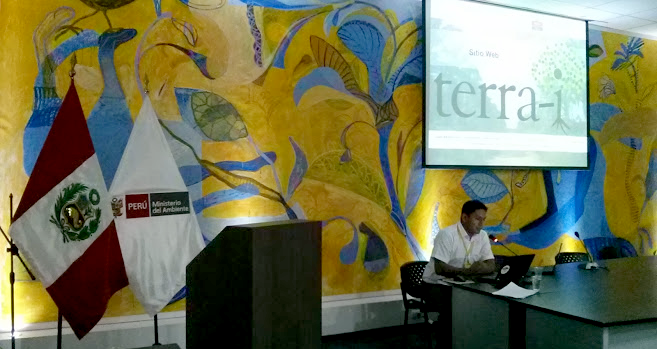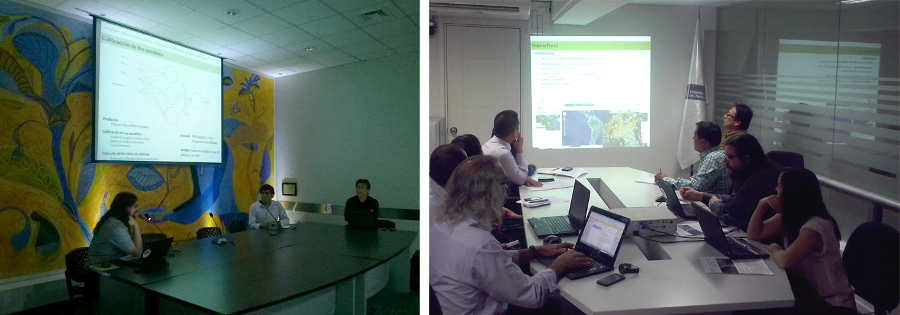

As part of the framework agreement signed on 10 March 2014 between the Peruvian Ministry of Environment (MINAM) and the International Centre for Tropical Agriculture (CIAT), The General Directorate for Territorial Planning (DGOT) organized a workshop to present the Terra-i Peru tool. The workshop was held on the 11th and 12th of March at MINAM facilities.

Figure 1: Jhon Tello, developer of the Terra-i web platform, showed the scope of the web viewer that is now available for use in the MINAM GEOSERVIDOR.
Terra-i Peru combines a set of tools designed for the detection and early warning of changes in land use and land cover using satellite imagery. It will allow officials from regional and local governments and other public and private institutions to contribute to improving land and natural resource management through sustainable use. The meeting was attended by representatives from the Peruvian Ministry of Economy and Finance (MEF), the Ministry of Agriculture (MINAGRI), the Supervisory Body for Forest and Wildlife Resources (OSINFOR), the Environmental Assessment of Oversight Agency (OEFA), and the National Service of Protected Areas by the State (SERNANP), among others.
As part of the workshop the Terra-i team released a video presenting the results its first field expedition at the end of 2013 near the city of Pucallpa in the Ucayali region, Peru.
Context of the Peruvian forests
According to the United Nations Food and Agriculture Organization (FAO), Peru has about 70 million hectares of forests, constituting 40% of the country’s land area and placing Peru second only to Brazil in total wooded area in Latin America. Peru's forests have suffered dramatic losses over recent years. Indeed, between 2000 and 2005 DGOT observed a total loss of 455,490 hectares. Since then the area of forest loss has nearly doubled, reaching a total of 865,292 hectares between 2005 and 2011.
Terra-i Peru provides information every 16 days on changes that happen in the Peruvian territory. Most of these changes are mainly caused by the development of human activities. Terra-i Peru is based on the analysis of MODIS and TRMM satellite images and has a spatial resolution of 250 meters. These characteristics makes it an important source of information for activities related to sustainable use and conservation of natural resources, biodiversity, adaptation to climate change and disaster risk management, among others. But it is especially important for the design of public policies to guide the various interventions in the Peruvian territory under the framework of the country’s Land Management Plan.

Figure 2: CIAT and DGOT staff attended the meeting together with guests from other Peruvian governmental institutions. Together, they defined the basis of a collaborative work plan within the framework of the agreement CIAT-MINAM.
The Terra –i team thinks it is crucial for a country like Peru to have access to information about what is happening to natural land covers in its territory that is as up-to-date as possible. The work of mapping and monitoring changes in the natural land cover (led by DGOT) allows authorities to be better informed for the guidance and efficient planning of the economic and industrial development of the Peruvian nation.
To this end, the general director of DGOT, Dr. Fernando Neyra, highlighted the efforts of cooperation between the MINAM and CIAT to generate proposals and actions regarding changes in land use. The Ministry will be able to “integrate the tool with existing land management priorities such as human impact and the set of physical and biological conditions that shape the territory.” Thus, he continued, “monitoring the surface of the earth will provide information related to economic dynamics and their impact on the territory."
The Terra-i team takes this opportunity to thank all the DGOT-MINAM staff for their interest in applying this tool to the Peruvian context. We also appreciated the enthusiasm of the workshop participants; their presence was key to set the parameters of a tool that will benefit many sectors of Peruvian society.
Blog post by Louis Reymondin. Revision of English-language version by Caitlin Peterson (CIAT / CCAFS visiting researcher).

The Terra-i team together with CRS El Salvador under the Raices project carried out a virtual workshop through the teams platform to technicians from the Ministry of Environment and Natural Resources, CARITAS, Universidad El Salvador, CENTA, about the Mapping of land cover using remote sensors and open source tools such as GEE, SEPAL and QGIS- Plugin Semi Automatic Classification.

Near real-time vegetation loss detection in Southwestern Ethiopia: calibration, validation, and implementation of the Terra-i system

The Alliance of Bioversity International and the International Center for Tropical Agriculture (CIAT) (the Alliance) conducted a training for local stakeholders on the use of Terra-i as part of the collaboration with the Netherlands Development Organisation – SNV in the Coffee Agroforestry and Forest Enhancement for REDD+ (CAFÉ-REDD) Project.


From May 8-12, 2017, the Terra-i team, together with staff from the DGOTA of Peru's Ministry of Environment, carried out the first field validation of vegetative land cover changes detected during Terra-i monitoring for 2016 and 2017, using the technology UAV. This work was carried out under the framework of the project “Sustainable Amazonian Landscapes”. The team carried out over-flights with a Phantom 3 advanced rotor drone and a fixed-wing Ebee drone in seven townships of Yurimaguas. The objective of this work was to recognize the dynamics of land cover and land use changes in the region while at the same time to validate the accuracy of the detections of forest loss being monitored by Terra-i in Yurimaguas.

The Terra-i team has worked hard on renovating Terra-i’s website since early this year. A set of new features on the website provides interactive contents and facilitates adaptation to the mobile devices of our users. The fresh website was developed using the latest update of an open-source, Java-based web system, Magnolia CMS 5.4.4. This update was customized to add different categories of interaction such as news, vegetation cover changes, and information, among others.

Globally more than 1 billion people depend on forests for their livelihoods. Forests play a crucial role in climate regulation, ecosystem services provision and regulation, water supply, carbon storage and many other functions that support biodiversity. Currently the global rate of deforestation is substantial, and there is a growing need for timely, spatially explicit data that flag natural vegetation changes due to human activities.

The latest update of Terra-i has been used with the Co$ting Nature ecosystem services assessment tool to understand the impacts of recent forest loss in Colombia on biodiversity and ecosystem services.

During the 1st and 12th of June 2015, the Terra-i team, together with the Instituto de Investigaciones de la Amazonía Peruana (IIAP) and the Universidad Nacional Agraria La Molina (VLIR-UNALM), conducted the second field validation of the data produced by the Terra-I system. This time, the study area was the Yurimaguas district, Alto Amazonas province, Loreto region (Peru). We used information on populated places, main roads, rivers and information on land cover changes detected for 2013, 2014 and 2015 to define the 65 sampling points (or Terra-I pixels) for the validation process (Figure 1).